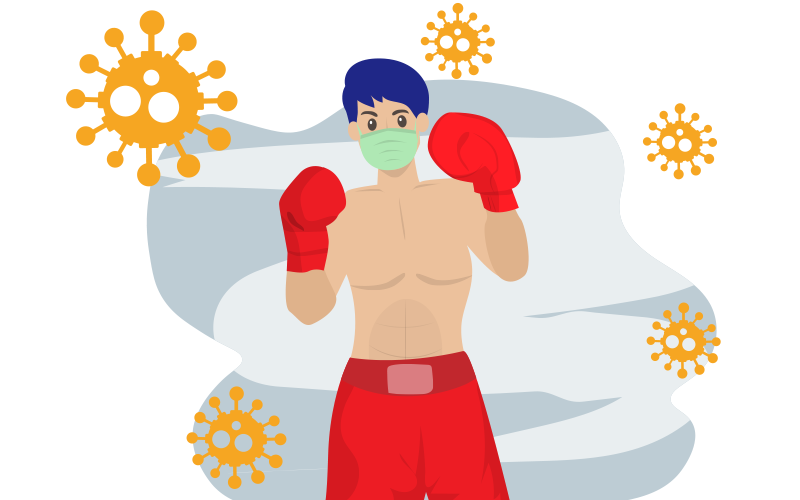‘Tis the season, flu season, that is!

This blog may have been posted after our holiday season celebrations with office parties and family gatherings.
As we return to our routine office schedules, we must maintain our respiratory health program with the most current and appropriate CDC infection prevention recommendations for the 2022-2023 flu season.
Influenza viruses are constantly changing, and even new viruses can appear each year and a gift none of us wants to receive.
Although the fall and winter is typically the most popular season for the flu to rear its ugly head, the season of flu can vary from different parts of the country and from season to season.
Annual flu is “a contagious respiratory illness caused by influenza viruses that infect the nose, throat and sometimes the lungs. It can cause mild to severe illness, and at times can lead to death”.1 (CDC influenza). Flu symptoms include:
- Fever
- Cough
- Sore throat
- Runny or stuffy nose
- Muscle or body aches
- Headache
- Fatigue
Transmission of the flu
Influenza spreads through droplets from coughing, sneezing, or talking that enter the respiratory system of another person through the nose or mouth.
However, touching inanimate surfaces contaminated with the influenza virus and touching your mouth or nose can transmit the virus less often.
Additional flu complications include bacterial infections such as pneumonia, ear infections, and sinus infections. The flu can also exacerbate medical conditions such as congestive heart disease, asthma, or diabetes. 1
Incubation and contagious periods
Flu can be spread even before symptoms appear.
The most contagious period includes the 3-4 days before becoming symptomatic.
The infectious period can even occur 5-7 days after becoming sick.
Those with weakened immune systems may be able to stay contagious for even more extended periods of time.
Symptoms usually occur after an incubation period of 1-4 days but typically after about two days.
Very young children, pregnant women, and persons of all ages with certain chronic medical conditions are most likely to get sick from the influenza virus.
Influenza and the dental office
As noted above, the incubation and contagious period for flu are relatively short; even those who are asymptomatic can spread the influenza virus.
In our dental environment, we need to reduce the chance that our patients can spread the virus to us, to another patient, or even from ourselves to our patients.
Just as we upped our respiratory protection protocol during the Covid-19 pandemic, we need to continue to have the standard precaution of respiratory and cough hygiene in place.
Respiratory hygiene/cough etiquette prevention practices are implemented to mitigate the transmission of pathogenic droplets and airborne particles.
Centers for Disease Control (CDC) Key recommendations for respiratory hygiene/ cough etiquette in Dental Settings
- Implement measures to contain respiratory secretions in patients and accompanying individuals with signs and symptoms of a respiratory infection, beginning at the point of entry to the facility and continuing throughout the visit.
a. Post signs at entrances with instructions to patients with symptoms of respiratory infection to—
i. Cover their mouths/noses when coughing or sneezing
ii. Use and dispose of tissues
iii. Perform hand hygiene after hands have been in contact with respiratory secretions
b. Provide tissues and a no-touch receptacle for the disposal of tissues
c. Provide resources for performing hand hygiene in or near waiting areas
d. Offer masks to coughing patients and other symptomatic persons when they enter the dental setting
e. Provide space and encourage persons with symptoms of respiratory infections to sit as far away from others as possible. Facilities may place these patients in a separate area while waiting for care. - Educate dental healthcare personnel on the importance of infection prevention measures to contain respiratory secretions to prevent the spread of respiratory pathogens when examining and caring for patients with signs and symptoms of a respiratory infection.
Vaccination of dental personnel
- Successful flu transmission management depends on well-defined administrative policies and adherence to the above key recommendations.
- However, annual vaccination is an essential measure to prevent seasonal flu infection.
- Vaccination is a strong defense, as we will not always know when exposed to someone with the flu.
- The CDC stresses that “vaccination after October can still provide protection during the peak of flu season.”
- The flu vaccine reduces flu-related illnesses and the chances of severe flu complications.
- Regardless of your vaccination status, you must continue to wear face masks in healthcare settings in compliance with the state or local health department mandates where you practice.
- And yes, it is safe to get a flu vaccine at the same time you get a COVID-19 vaccine, including a COVID-19 booster.
- If you are unfortunate enough to come down with the seasonal flu, your doctor can prescribe an antiviral drug to lessen the severity of your symptoms. The antiviral drugs must be given within 1-2 days after your symptoms begin.
Our flu transmission responsibilities
According to the CDC, as dental personnel, we are responsible for monitoring our health status.
We need to get yearly flu vaccinations, and if we're sick, especially with flu symptoms, we should stay home.
We're also responsible for providing an environment for our patients that limits airborne disease transmission by following key CDC recommendations for respiratory hygiene/cough etiquette protocol.
- I wish you all a Happy, Healthy Holiday NO-FLU Season!!!!







